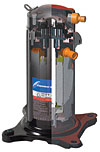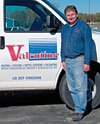
“I don’t think anybody who was on that [scroll technology development] team 20 years ago would have forecasted that we would have nearly 60 million pieces in the field today, 10 plants around the world, and scroll models from one to 30 horsepower... nobody would have envisioned that,” assured Ed Purvis, Emerson group vice president of Emerson Climate Technologies Refrigeration.
“We’re very excited about what we’ve accomplished. Global scroll sales are up to $1.7 billion this year,” said Tom Bettcher, CEO, Emerson Climate Technologies. “It’s had a growth rate over the last five years of about 15 percent. So, we’ve doubled the revenue over the last five years. And, a lot of that was accomplished because many reciprocating markets converted to scroll.”
With that in mind, Bettcher spoke of the future for Copeland Scroll and Emerson Climate Technologies. To continue moving the company upward, Bettcher and Emerson have put together a growth plan that takes into account the versatility of Copeland Scroll and the opportunities it creates to reach out to new markets.
“There are new technologies that help us move into emerging markets, thanks to the modulation of Copeland Scroll - either the two-step UltraTech, that we’ve launched in North America, or the Copeland Scroll Digital product, which is used worldwide,” said Bettcher. “So you have a lot of different opportunities to add value to systems and improve efficiency.”
From the above two examples alone, Bettcher said Emerson will drive future off-shoots of scroll technology and numerous other new products that the company plans to come out with in the near future.

NEXT BIG CHALLENGE
In Emerson’s estimation, the industry’s next big challenge is the R-22 refrigerant phase-out in 2010. It has already been on the company’s “to-do” list for quite some time.“We started in 1995 in our residential products and 2001 in our commercial products,” stated Scott Barbour, president of Emerson Climate Technologies Air Conditioning division. “So today we have a full suite of R-410A products. We could make this change tomorrow.”
This does not mean that the industry as a whole is currently ready for the phase-out.
“We feel we did a decent job of helping the industry through the 13 SEER transition, after we began to understand and communicate what was really needed. I think we can do a better job this time by driving that awareness much earlier in the process. It will not be a trivial change by any stretch.”
The company has experience with R-410A and an installed base of nearly five million R-410A units.
Barbour added, “We think that there is a big job for us to do at Emerson: to drive awareness to get people ready for this transition because it’s in the industry’s best interest that it go well.”
From a new product standpoint, what Emerson is working on addresses the 2010 refrigerant change and looks forward to future regulatory issues. It is addressing residential, commercial, and refrigeration application needs for best performance, but also aiding contractors and manufacturers by giving them the products and tools they need. That’s another big reason why it plans to provide more education for all parties in the industry.
“Much like we did when the 13 SEER issue had to be addressed, we’ll have a very focused campaign around educating the contractor,” assured Barbour. “We’ll have all kinds of materials ready for them through our application engineering, education and corporate communications organizations.”
Emerson is shooting for a smooth transition, whereby its customers will be able to have the same broad product lineups each has today.

MORE ENERGY-EFFICIENT EQUIPMENT, SYSTEMS...PLEASE
With up-and-coming energy regulations, both here and across the globe, Emerson knows it has to be in the forefront of the expected changes. Not surprisingly, energy-efficient equipment will continue to grow in importance. Emerson leadership believes Copeland Scroll will continue to enable HVACR equipment to reach higher and higher levels of efficiency - mandated or otherwise.“I think the whole energy crisis is a huge opportunity, not only for us, but for the industry because it requires more efficient equipment. It requires new technology,” expressed Bettcher. “There will be legislation in North America, at the federal level. We’ve already heard that we might have regional regulations and some of them could be very aggressive. And every time those legislative activities occur, they call for higher efficiency.”
With Copeland Scroll considered to be the most efficient compressor, Bettcher believes it gives Emerson another step up in terms of its ability to bring value to the marketplace.
Looking outside the box, Purvis believes Emerson has just scratched the surface in what it can do with electronics.
“Where we should be clear is this: Effective application of electronics can provide a very integrated solution involving compressors, motors, and flow devices,” he said. “And when you look at the capability of what we can do to help our OEMs develop systems that optimize operating efficiency based on certain conditions, the possibilities are endless.”
In many ways, Barbour believes the learning curve in electronics over the next 20 years will be comparable to when Copeland Scroll was launched back in the late 1980s.
Bottom line: Electronics is the next frontier. Therefore, Emerson plans to marry Copeland Scroll with electronics to produce better performance and advanced communications. Its current UltraTech Communicating System was created and built on this idea.
“I think we’ve learned a lot through the launch of the UltraTech Communicating System and the Comfort Alert diagnostic products that we’ve brought out,” said Bettcher. “Our first idea was not particularly popular with contractors, so we changed it before we launched it. And now we’ve got a success story instead of just technology sitting on the shelf waiting for someone to decide if they like it.”
Barbour said the sharing process has two benefits.
“First, you get it right the first time,” he said. “But the other benefit is that they [contractors] embrace you as a trusted partner, as well as a provider of products. I can’t imagine launching a new product without going to a contractor first and saying, ‘Tell us what you think.’ ”

Click on the image for an enlarged view.
NEW HORIZONS, MARKETS, AND A BRIGHT FUTURE
To summarize Emerson’s future business strategy, Copeland Scroll will be counted on to continue expanding, application by application and installation by installation, around the world. At the same time, Emerson’s global footprint will be around to provide support for global HVACR manufacturers. Whereas in years past Emerson exported Copeland Scroll around the world, they now have scroll manufacturing facilities throughout Europe and Asia to meet the growing demand for the compressor in those markets.“We have seven major platforms with hundreds of derivative products and over one thousand models,” said Bettcher. “And it’s opened up new and in some cases unexpected markets.”
According to Purvis, there has been a 20- to 30-percent annual growth rate in Copeland Scroll sales in refrigeration. One reason for the boost is due to the company stepping into new markets and applications.
One unique area for Copeland Scroll is in medical refrigeration - keeping blood plasma, for example, safe and sound.
“It’s one thing when your air conditioner breaks at home and you’re a little uncomfortable for a couple of days,” said Purvis. “It’s another thing when you have an MRI machine in a hospital or refrigerated plasma in a blood bank. Those are applications where reliability is a must and Copeland Scroll has been quickly adopted there because of its reputation for durability and reliability.”
Bettcher is quick to point out two new markets that were not on Copeland Scroll’s radar screen originally: transportation and home heating in Northern Europe. In transportation, scroll compressors are now used in trucks, trailers, and sea containers, along with air conditioning for buses.
As Bettcher put it, the company also “did some very creative things” with Copeland Scroll technology so that it can heat water like a boiler, using heat pump technology familiar to North America. This new scroll application has become “our highest growth product in Europe, without question,” said Bettcher.
“And in the next five years we think that could become the biggest product line in Europe for us,” he said. “As a compressor manufacturer, we always looked at the boiler market and said, ‘we’ll never be in that business.’ And now it’s becoming a ‘compressorized’ product.”
In other words, as Copeland Scroll is branching out into other industries and applications, Emerson Climate Technologies will be right there, pushing it along with investments to support these new growth opportunities.

Bruce Diedrick, HVAC manager at Valentine Heating and
Cooling has seen Copeland Scroll move from intriguing new technology to a key to
his business. (Click on the image for an enlarged view.)
Sidebar: Contractors Tout Benefits of Scroll
A major factor in the early and sustained success of Copeland Scroll is the inherent benefits it offers and how those benefits impact HVACR contractors. Some of the most important product attributes that contractors look for; reliability, energy efficiency and compressor sound; are addressed by this technology.Perhaps first on the list is reliability. According to Ray Isaac, president of Isaac Heating and Air Conditioning, Inc., in Rochester, New York, and incoming chairman of the Air Conditioning Contractors of America, the reliability of Copeland Scroll was crucial, as they had to be confident in the products they installed.
“Customers associate a product’s reliability with the contractor - that all comes back on us. So we’re very careful about what we put into our customers’ homes. The Copeland Scroll was extremely reliable, and it’s gotten even better throughout the years.”
Very soon it was apparent that not only was the technology more reliable than what contractors had previously worked with, but that it introduced several additional benefits.
“With the size of the compressor, it was unbelievable to think that something that small not only could do the job, but with better energy efficiency,” said Bruce Diedrick, HVAC manager at Valentine Heating and Cooling in Kaukauna, Wisconsin. “And the sound levels were very impressive; it seemed like it wasn’t exerting any effort because it was so quiet, and that was a big selling point for our customers.”
In fact, Isaac noted that the benefits he noticed with Copeland Scroll, played directly into the way he sold to his customers, and still does.
“I had a lot of confidence in the new technology, pretty early on. The simplicity of design, the quiet operation,” Isaac said. “It offers all of the things that we can translate into value for our customers; it’s quiet, it’s reliable and it’s efficient.”
Diedrick also gives a lot of credit to Copeland Scroll for making his job in selling to his customers a little bit easier.
“Copeland Scroll is one of the key things I bring up when I’m talking to a homeowner or commercial customer,” Diedrick said. “I’m finding a lot of customers are doing their homework online, and they’re learning that Copeland Scroll is the best compressor. Add to that the great warranty, the proven product – just mentioning to a homeowner that they can sit on their patio and their system will be so quiet they hardly notice it, those things go a long way.”
Publication date:11/12/2007

Report Abusive Comment